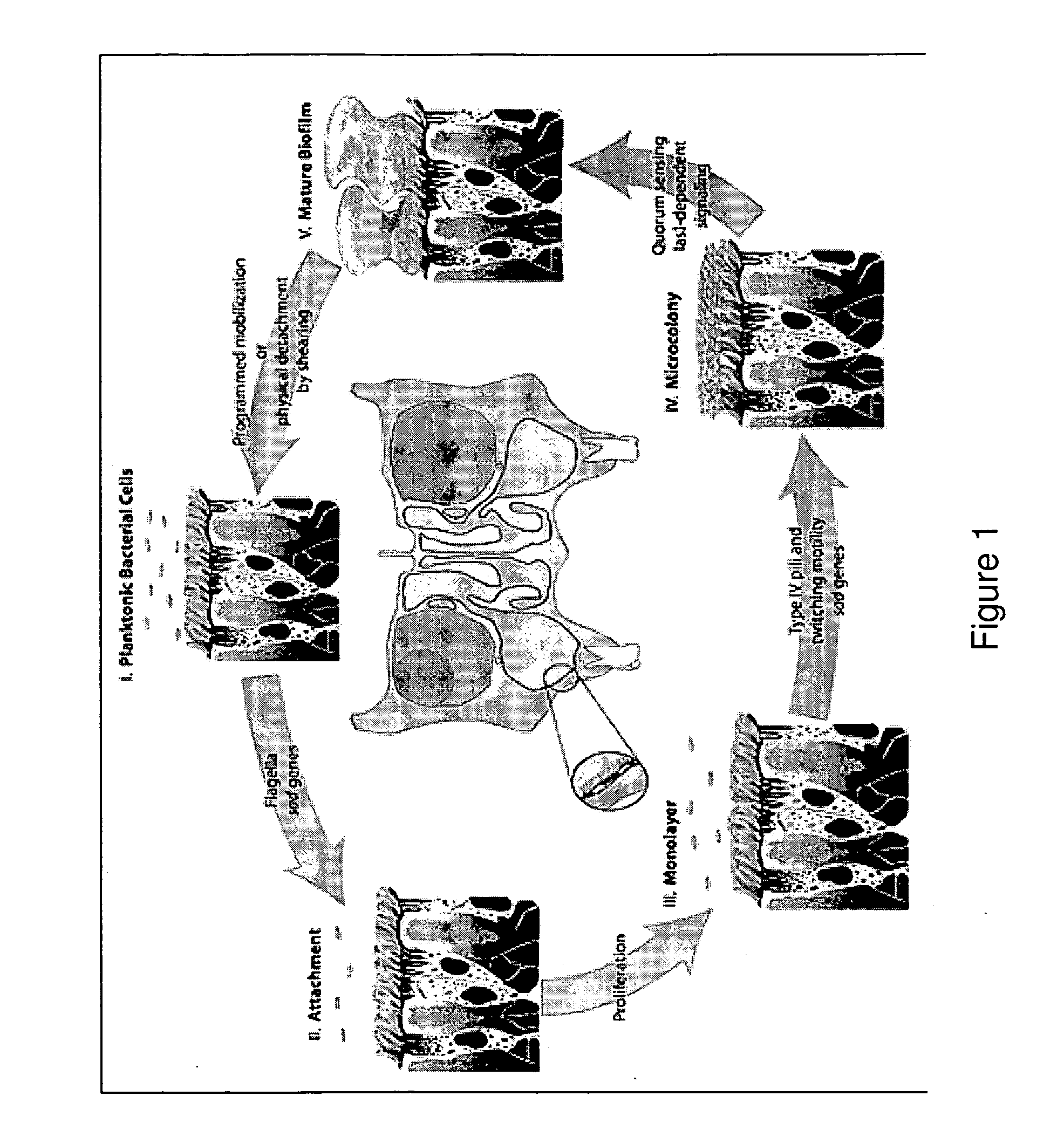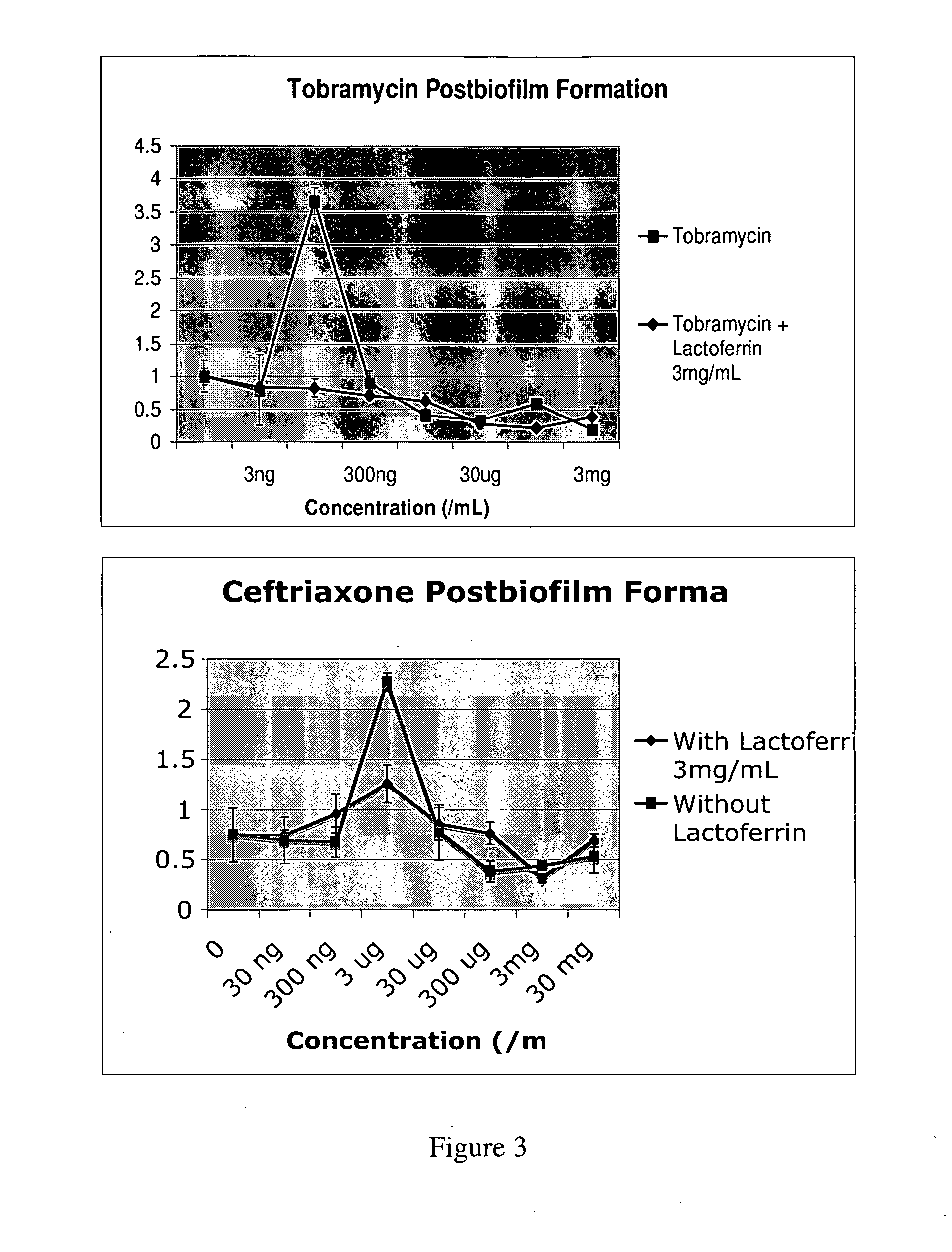Biofilm prevention using lactoferrin
a technology of lactoferrin and biofilm, applied in the direction of transferrins, peptide/protein ingredients, antibacterial agents, etc., can solve the problems of very problematic infections with associated biofilm formation, and achieve the effect of preventing biofilm formation
- Summary
- Abstract
- Description
- Claims
- Application Information
AI Technical Summary
Benefits of technology
Problems solved by technology
Method used
Image
Examples
example 1
Lactoferrin Blocks the Antibiotic Induced Biofilm Formation
[0071]In efforts to develop rationale topical therapy for post surgical chronic rhinosinusitis, a topical irrigation animal model of biofilm sinusitis was developed. The animal model was coupled to an in vitro biofilm eradication assay [Moskowitz, S. M., J. M. Foster, J. Emerson, et al., Clinically Feasible Biofilm Susceptibility Assay for Isolates of Pseudomonas Aeruginosa from Patients with Cystic Fibrosis. J Clin Microbiol, 2004. 42(5): p. 1915-22] for high throughput screening of combinations of therapies. During these efforts of combining rhLF with antibiotics the following observations were made: (a) antibiotic in other classes (cephalosporins) induce biofilm formation; and (b) the addition of lactoferrin blunts the antibiotic induced biofilm formation. As shown in FIG. 3 induction of biofilm formation by subtherapeutic concentrations of Cephalosporins as well as aminoglycosides is blunted by the addition of rhLactofer...
example 2
Surfactants Induce Biofilm Formation
[0072]Utilizing the same rationale and process described above, the utility of detergents and clinically used surfactants (biologic detergents) as a potential therapy for biofilm infection was investigated. Surprisingly, it was found that under certain conditions detergents can induce biofilm formation (FIGS. 4 and 5) and that rhLactoferrin inhibits detergent induced biofilm formation.
example 3
Baby Shampoo / Chemical Surfactant Nasal Irrigations for the Symptomatic Post-Fess Patient
[0073]A non-randomized study of CRS patients who remain symptomatic despite a previous history of sinus surgery and conventional medical therapy, including oral and topical steroids, antibiotics, oral and topical anti-histamines and saline irrigations was performed. Many of these patients had also received previous trials of “non-conventional” therapies, including topical antibiotic irrigations, systemic and topical anti-fungals and nebulized antibiotics.
[0074]Symptoms prior to and following treatment with baby shampoo / chemical surfactant irrigations were recorded using a validated quality of life form, the SNOT-224.
[0075]Objective assessment of olfactory function using the UPSIT5 was performed prior to and following therapy. Side effects and reasons for discontinuation were recorded in a patient diary, and the patients were seen four weeks after starting the baby shampoo / chemical surfactant irri...
PUM
| Property | Measurement | Unit |
|---|---|---|
| time | aaaaa | aaaaa |
| density | aaaaa | aaaaa |
| biofilm eradication concentration | aaaaa | aaaaa |
Abstract
Description
Claims
Application Information
 Login to View More
Login to View More - R&D
- Intellectual Property
- Life Sciences
- Materials
- Tech Scout
- Unparalleled Data Quality
- Higher Quality Content
- 60% Fewer Hallucinations
Browse by: Latest US Patents, China's latest patents, Technical Efficacy Thesaurus, Application Domain, Technology Topic, Popular Technical Reports.
© 2025 PatSnap. All rights reserved.Legal|Privacy policy|Modern Slavery Act Transparency Statement|Sitemap|About US| Contact US: help@patsnap.com



